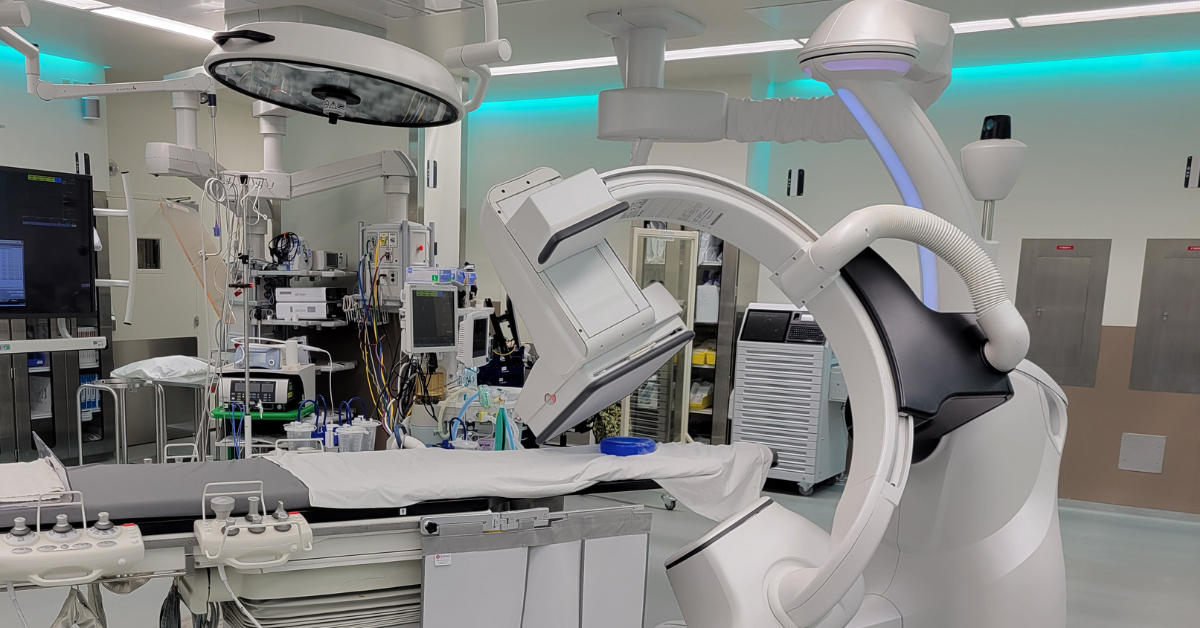
In today’s hospital cath lab environment, space is hard to come by. Ceiling space is being consumed by monitor suspensions, radiation shields, surgical lights, medical gasses, and more. Floor space is covered with a myriad of things from anesthesia machines to portable radiation shields. All that and we haven’t even considered the staff!
To help combat this, GE introduce the Discovery IGS series of cath labs that include a unique innovation. While traditional cath lab gantries are bolted to the floor or hang near the table from a ceiling suspension, the Discovery IGS systems have a gantry mounted to the “Advanced Guided Vehicle” or “AGV.” This feature lends itself to freedom in the workspace because of how gantry can be moved around to meet multifaceted needs of the clinical staff. This would be enough of a selling point for a hospital looking for a more adaptable system, but that’s not the only reason customers look for a GE Discovery IGS 730 or 740.
Read on for our analysis of these Discovery IGS systems and how these systems are a bit different than the standard GE cath labs.
Note: Block Imaging provides new and refurbished cath lab machines and parts in order to solve all the pain points listed above. You can read about it in detail below or reach out to our sales team to learn more about how it can help improve diagnostic imaging.
- How does the gantry in the GE Discovery IGS series work?
- Are the GE Discovery IGS units similar to the rest of the GE cath labs?
- How does the GE Discovery series impact hybrid rooms?
- Conclusion
How does the gantry in the GE Discovery IGS series work?
This AGV is a gantry on wheels that can be moved into preset park positions when not in use, creating 360-degree access to the patient table. It also has many preset positions around the table that can be set for repeatability of positioning.
The advantages
With this new gantry comes a couple noticeable new hardware wrinkles. The top of the gantry has a spinning laser system that is calibrated with mirrors installed around the room, so the gantry knows precisely where it’s located. This allows for many preset locations to be saved in the gantry for repeatable, hassle-free positioning.
Another noticeable difference is that with the lack of a fixed mounting point, the cabling for the gantry runs up into the ceiling. The entry point into the ceiling is far enough back from the head end of the table that it is out of the way of any ceiling mounted equipment and typically won’t be of concern.
Some things to consider
One additional option GE has provided is the OR Table. This table has been engineered with the IPX4 level of protection against fluids, meaning it’s designed to keep fluids out of the internal portions of the table. We think this is a great option when considering what it’s being used for, and the various fluids the table could come in contact with.
While these systems offer incredible flexibility, one challenge in the site preparation process is regarding the flooring. Because the gantry is mobile, there are tight tolerances for the levelness of the flooring. Because of this, GE requires a self-leveling epoxy flooring be poured. This is expensive, and there are typically a smaller number of contractors available that are familiar with the material, especially as locations become more remote.
GE also introduced an OR series with Maquet Magnus OR table system for even more flexibility. As a result, every iteration of the GE Discovery 730 and 740 truly makes the most of the space its in, benefitting access to patients and ease-of-use to physicians, nurses, anesthesiologists, and technologists.
Are the GE Discovery IGS units similar to the rest of the GE cath labs?
For the system itself, there are many similarities with the rest of the GE line of cath labs. The Discovery IGS units use the same X-ray tube, tube chiller, general cabinet architecture, and detector conditioner as the Innova IGS 520, 530, and 540 systems. The detectors are the same as well:
- The GE Discovery IGS 730 has the 31cm x 31cm detector, the same size as the GE Innova IGS 530 system.
- The GE Discovery IGS 740 has the 41cm x 41cm detector, the same size as the GE Innova IGS 540 system.
How does the GE Discovery series impact hybrid rooms?
In today’s hospital environment there is a push for hybrid rooms that combine the diagnostic capabilities of a cath lab with the surgical equipment typically found operating room. With the goal of improving patient outcomes, the hybrid lab allows physicians to act quickly without the need to move the patient to a different room, allowing the ability to quickly confirm via imaging the work performed was successful.
While the GE Discovery IGS 730 and 740 systems fill a specific niche in the hospital environment, these systems are not mainstream, and so for most sites they would be considered overkill. That said, if you’re in need of a hybrid OR suite, this is still a solid choice.
Conclusion
This system overview wraps up our series on GE cath labs. If you’re curious about the other systems we covered, explore our list!
- Optima CL320i
- Optima CL323i
- Innova IGS 320 and 330
- Innova IGS 520, 530, and 540
- Innova IGS 620 and 630
If you have any questions about the Discovery IGS 730 and 740 or about any of the other systems covered, don’t hesitate to reach out to us. We have a dedicated team with decades of experience in this area who would love to help you with your diagnostic imaging goals in any way they can.

Kenn Dextrom
Kenn Dextrom is the Director of Product Manager at Block Imaging. He aims to provide clear direction and careful planning for Interventional Cath Lab buyers and working with the Block Imaging product team to provide excellent solutions for our customers. Out of the office, he spends most of his time keeping up with his wife and their three energetic sons.





